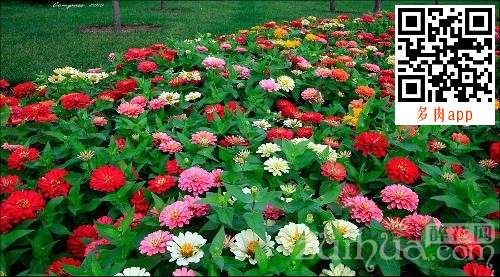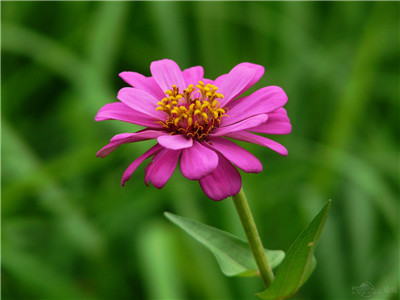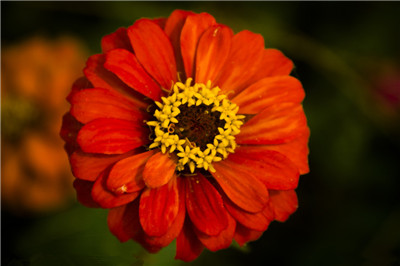Cultivation and maintenance methods of zinnia
Hundred-day grass is a hundred-day grass,-annual herbs, strong sex, like warmth, not resistant to cold, like light, more tolerant to drought. The suitable temperature for germination is 22-25 degrees Celsius. When sowing, it should be slightly covered with soil and placed in a place away from light. After the true leaves grow, they should be transplanted immediately.
The zinnia grows very fast and is easy to grow in vain, so it is necessary to pick the heart in time to promote the growth of axillary buds, so that the flower plant is stout and the flower setting rate is high. Zinnia is a 1-2-year-old herb, its leaves opposite, sessile, composed of ligulate flowers and tubular flowers. Because the zinnia is a relatively short-day plant, the method of regulating the sunshine length can be adopted to regulate the florescence.
When the sunshine is longer than 14 hours, the flowering will be delayed, and it will take about 70 days from sowing to flowering, and the number of tongue-shaped flowers will increase significantly; while when the sunshine is shorter than 12 hours, it can blossom in advance, and it will take only 60 days from sowing to flowering. At this time, there are more tubular flowers. In addition, the flowering period can also be controlled by adjusting the sowing time and coring time.
In the process of sowing, zinnia requires a well-drained, loose and fertile soil environment. Usually the germination temperature is 21-22 degrees, it needs to be covered with soil when germination, and it can germinate in 2-5 days. In the process of growth, the daily temperature should be kept at 18 degrees and the night temperature should reach 21 degrees. The time from sowing to flowering is 9-10 weeks.
In addition, it is worth noting that the continuous cropping of hundred-day grass should be rotated in time because the hundred-day grass is easy to grow in the later stage of growth. for this reason, growers usually take the following measures to control it:-to appropriately reduce the temperature and increase ventilation; to ensure adequate nutritional area and increase plant spacing; third, to pick out the heart in time to promote axillary bud growth. The specific operation method is carried out when the plant height is about 10 cm, leaving 2 to 4 pairs of real leaves to pick the heart. If you want to make the plant low and blossom, you often spray dwarfing agent when the axillary buds grow to about 3 cm after coring. For seedlings that are not overgrown, they can be cultivated in the open field, and coring treatment should be carried out in order to limit their growth height.

The first stage: 3 days after sowing, the radicle is on display, the degree of wetness of the medium should be relatively dry, too moist, easy to cause seed rot. However, it is very important to maintain moisture and sufficient oxygen around the seeds at this stage, so it is very beneficial to seed germination to cover with a thin layer of coarse vermiculite or loose ridge ash after sowing. Open seedlings must be covered with shade nets to ensure humidity and lower temperature (if sowing in the germination chamber, appropriate supplementary light can be given). No fertilizer is needed at this stage. The second stage: keep the soil relatively moist, neither too wet nor too dry, too wet can easily cause disease, too dry will lead to seedling wilting. At this time, the main root grows to 1-2cm, the cotyledons expand, and the first pair of true leaves begin to grow, and the seedlings can gradually see light. Fertilization can be started, generally using 0.05% urea or 50ppm20-10-20 water-soluble fertilizer, N can promote vegetative growth. The third stage: when the seedlings enter the rapid growth period, the water management should be strengthened and the circulation process from dry to wet to dry should be carried out, which is beneficial to the root growth of seedlings and can also avoid overgrowth. At this stage, attention should be paid to pest control, 0.1% urea or compound fertilizer can be applied properly, and the proportion of N-P-K can be 15-15-15 (or according to the market supply, the content of N and K can be slightly higher. P content can be on the low side. If the conditions permit, the temperature of the medium and environment should be reduced to about 20 ℃, but it is difficult to control the temperature when sowing under the condition of bed sowing, and the full light environment is needed at this stage, otherwise it is easy to cause seedlings to grow. According to the growth trend of the seedling stage, the moisture should be controlled properly. Pay attention to the ventilation of the environment to prevent diseases. Spray chlorothalonil or methyl topiramate every other week or so. If overgrowth occurs at this stage, B9 should be sprayed immediately to control the height. The fourth stage: the root system has been well formed, and when there are 3-4 pairs of true leaves, overgrowth occurs. B9 should be sprayed immediately to control the height, and the temperature and humidity requirements are the same as the third stage. After the seedling refining stage, it is ready to be transplanted into the pot. Transplant / upper basin: when there are 2-3 pairs of true leaves, they can be transplanted into the pot; if they are seeded on the plate or in the bed, they can also be put on the pot directly when there are 3-4 pairs of real leaves. According to the requirements of plant height and plant diameter, the nutrition bowl of 12 × 13 is generally used, which can be put in place at one time, and there is no need to change the basin. The root system of hole-plate seedlings is less damaged and the transplant is easy to survive; for open seedlings, more mud should be carried out as much as possible, and the transplanting time should be carried out in the evening or cloudy days to improve the survival rate. Light regulation: zinnia is a positive plant, growth and flowering require sufficient sunlight, lack of sunlight is easy to produce stem node length, affecting the ornamental effect. There is no need for shade during the whole growing period after potting. Temperature control: zinnia likes temperature, but under the extremely hot summer conditions, the growth potential is slightly weaker, the flowering effect is not ideal, and the optimum temperature for growth and flowering is 15-20 ℃. The sowing date of zinnia is controlled in summer to prepare flowers for National Day. During the growth period, the high temperature above 35 ℃ generally will not affect the growth. Cultivation management: when there are too many Rain Water in the rainy season, it is easy to cause excessive elongation of internodes, so attention should be paid to eliminating stagnant water and spraying B9 at an appropriate time; long sunny and little rain in summer, too dry, easy to weaken the growth potential and affect the color of flowers, water and fertilizer management should be paid attention to at this time. During the whole growth period, proper water control and dry humidity between basin and soil are beneficial to root development and height control. Potted fertilizer is usually applied once every 7-10 days, and topdressing can be carried out depending on the growth. 0.2% urea and compound fertilizer are used at intervals, and urea is stopped one month later. According to the growth condition after flowering, the interval of topdressing application of compound fertilizer can be prolonged appropriately. Because the lateral branches of zinnia have the habit of terminal bud flowering, if the natural growth is not controlled, the flowering site will be higher and higher, affecting the beautiful plant shape, timely coring before and after transplanting and controlling the plant shape. In general, 2-3 pairs of true leaves are retained. Hundred-day grass can be pruned, but it grows poorly after pruning, so this method is generally not used. Diseases and insect pests: the main diseases of zinnia are: seedling stage quenching disease, growing period bacterial wilt disease, stem rot disease, leaf spot disease; insect pests are: night moth, red spider, cabbage worm and so on.
- Prev

Field management of zinnia
Plant stereotyped management: if the zinnia is not treated with coring, there are too few lateral branches and few flowers, and proper coring can promote the dwarfing of the plant and the increase of flowers. When the seedlings grow to 4 leaves, plant and pick the heart to promote the growth of lower branches to form a better plant shape. Planting-begin to pick the heart after a week, leaving 4 pairs of true leaves
- Next

Key points of maintenance of zinnia
The key points of flower cultivation of zinnia are mainly divided into four aspects: temperature, sunshine, moisture and planting density. Temperature: hundred-day grass likes to warm to the sun, can not bear the heat, high temperature and cold, the suitable growth temperature is 18-20 degrees Celsius during the day and 15-16 degrees Celsius at night. It grows especially fast in summer.
Related
- Fuxing push coffee new agricultural production and marketing class: lack of small-scale processing plants
- Jujube rice field leisure farm deep ploughing Yilan for five years to create a space for organic food and play
- Nongyu Farm-A trial of organic papaya for brave women with advanced technology
- Four points for attention in the prevention and control of diseases and insect pests of edible fungi
- How to add nutrient solution to Edible Fungi
- Is there any good way to control edible fungus mites?
- Open Inoculation Technology of Edible Fungi
- Is there any clever way to use fertilizer for edible fungus in winter?
- What agents are used to kill the pathogens of edible fungi in the mushroom shed?
- Rapid drying of Edible Fungi

